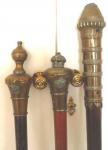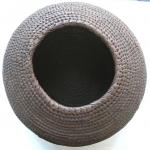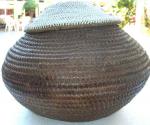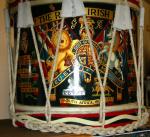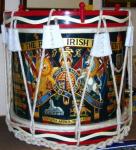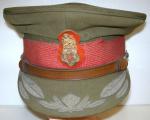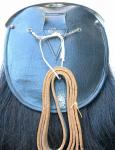-
Posts
13,225 -
Joined
-
Last visited
-
Days Won
22
Content Type
Profiles
Forums
Blogs
Gallery
Events
Store
Everything posted by Mervyn Mitton
-
Have managed to separate them - so will post now to keep them together. Strictly speaking these are civil - rather than police - however, the similarity to British regalia is very apparent. The one thing you have to admire the British for - is total arrogance !! We knew we were right - and never deviated from that opinion - why do I say this ? Quite simply - these were given by the British administration in Nigeria as status symbols for THIRD class chiefs... Only we - could designate someone as a third class - but, still give him an impressive staff for authority !! These date back to the reign of King Edward 7th. (1901-1910) and they are brass ended , with a crown surmounting. They actually look very impressive when polished. I have never seen the badge of office for a 2nd. class - however, I understand it was a badge and not a staff - perhaps Peter can help on this ? For a first class chief the top was in solid silver and was - surmounted by a large cast silver hippoptamus (this may have varied). The oldest stick and umbrella company in England is opposite Holborn Police Station - they made them for the Govt. and have one on display. Apart from that one, mine are the only other ones I have seen - if anyone can help with pictures or, more info. it would be good.
-

EARLY INDIAN POLICE STAFF
Mervyn Mitton replied to Mervyn Mitton's topic in Police Forces of the World
-
Have just had a camera disc sent from UK which has some more pictures of the collection. Unfortunately items on this frame have been put together - for clarity, I will discuss them separately, but this will mean showing the illustration again - not a problem, they are different Countries. We are looking at the right hand staff - the largest one and without anything on top. The original contract to trade with India , was given by Charles 2nd. in the 17th. C. to the East India Company and they ended up establishing it as a colony with it's own police,army and navy. After the Indian Mutiny Britain took direct control and the EIC lost power. Whilst organised police forces were in the larger centres, they copied the English system of having a constable in villages. His only weapon was the LATHI (pronouced lassie) which - without the brass is still used in India today to control riots. The staff could be used to strike down - prod in the stomach - or, swept at knee level to keep crowds back. A fearsome weapon in the right hands. This example almost certainly dates back to the early 19th C. and is rare. I expect they could still be bought in the markets - or, at least the brass heads, but I doubt the bamboo would have survived. Should anyone have any pictures or, further details it would be of interest.
-
The whole concept of policing was new - and the idea of the constable always being available was quite radical. Since he had to be on duty at all times he needed to be able to show when he was 'officially' on street duty - however, if anything happened. then he put himself 'back on duty' and did what was necessary. This still applies today - Robin, Leigh Coldstream and other retired Police - will tell you that they were always 'on duty' and were expected to act accordingly. An example would be if you were on holiday and saw a serious crime - then you took action as a police officer - since England and Wales are jurisdiction areas - Scotland being separate - then that was the area you had authority. Most police I knew would not become involved unless it was very serious - but, in the Met. you usually got a Commissioner's Commendation for acting out of your area.
-

Zulu items
Mervyn Mitton replied to helen's topic in Great Britain: Militaria: Badges, Uniforms & Equipment
-

Zulu items
Mervyn Mitton replied to helen's topic in Great Britain: Militaria: Badges, Uniforms & Equipment
Very old Zulu beer pot (thought of Chris immediately !!). Made from woven reeds it is totally 'water' proofed. The small cover on the top has a bead decoration and was intended to keep flys and insects out of the beer. They made the beer in larger containers and - as needed - put it into these smaller containers. Beer is not as we know it - or, as alcoholic - it is brewed from maize and is nutritious. I have not had an answer from the Museum re. the Isikokos (head rings) - I think we have come across an important item of knowledge - Helen, would you feel a paper is justified - and more importantly, would you be interested ? I will continue to post old pieces from time-to-time - Google seem to be enjoying them !!! -
When the first civilian police force in the World - the London Metropolitan police - marched out from New Scotland Yard in 1829, their uniform was based on the civilian dress of the day. Totally different working conditions existed in those early days and it was clearly laid down in Instructions, that the constable was to wear his uniform at all times and he was, therefore, on duty at all times. The difference between parading on duty and being on 'off' duty , was to be shown by an arm band worn around the left wrist of the tunic. The first ones were horizontal in their striping and only had a few rings - by the time I joined they were vertical and in alternate stripes of blue and white. The top one was my first issue in 1967 and was of a cloth - the replacement was nylon. They were discontinued in - I think 1972 or,73.. They were not the easiest things to put-on in a hurry - it took practise to have them lie flat around the cuff. The City of London Police had red and white stripes and still wear them - the only Force - to my knowledge - who still keep up their traditions.
-
Very rare side drum (often called a 'snare') for one of the British older Regiments. THE ROYAL IRISH REGIMENT was originally formed in 1684 as the 18th. Regiment of Foot. One has to remember that King Charles 2nd. died in 1683 and his brother - King James 2nd. was forced out of Britain - he was Catholic and became known as the 'Old Pretender'. His son was 'Bonnie' Prince Charles - who became the 'young pretender' and invaded England in the 1740's. England had difficulty in finding a replacement for James and eventually settled on the daughter of King Charles 1 st. (who was be-headed by the Parliamentarians under Cromwell) - she had married the Prince of Orange - ruler of Holland. She would only return if her husband - Prince William, was made joint ruler and so it happened that for the first and only time, Britain had a King and a Queen - and not a Monarch and Consort. With the expulsion of James - and his settling in France and trying to cause revolution, many extra Regiments were formed - The 18th. of Foot being one of them. The Battle Honours shown are quite exceptional - they were present at all of the Duke of Marlborough's battle in France - and when you read through them - they were present at most during the 18th. and 19th. Centuries. The Regiment was disbanded in 1922 - with the Dissolution of Ireland - however, they were re-formed in 1992 with regiments from Northern Ireland. A 238 year old history to be proud of !! Military side drums - of this quality - are exceptionally rare on the market and are worth many thousands of Pounds. We can tell a lot from the details on this one and , can date it quite accurately. When the Regt. was dis-banded in 1922 the drums were probably gifts to the different Colonels of the Regt. - and with death, this one probably came onto the Market. All of the painting is hand done - and the artist - Collins - signed in the lower right corner. The drum is also signed Hawkes. This was the maker and Boosey and Hawkes are one of the great names in British military bands. The Royal Cypher is for King George 5th. - who came to the Throne in 1910. The drum was probably made especially for the Coronation Procession in 1911. World War One started in 1914 and the Regt. ceased after 1922 - so, to me, there is a narrow window for dates - 1910 to 1914 - because, we weren't making drums after 1914 ! This has to be one of the rarer items posted on GMIC and I will welcome any additional information. **NOT FOR REPRODUCTION OR, USE, WITHOUT WRITTEN PERMISSION**
-
An interesting small group of three - QSA + WW1 pair. QSA - bars for OFS and Transvaal. Named to: Pte. Johnstone Jo'burg Mounted Rifles. WW1 Pair : Spr. Johnstone WSC (Water Supply Co.) I think this naming to a Company of what must be a Battalion to supply water, makes this quite rare. I have seen named units for electrical supply, but not Water - and yet, if you stop and think, they had to have water. Will be pleased to see what other members think ?
-

Rare Zulu War Bar ?
Mervyn Mitton replied to Jeff Mc William's topic in Great Britain: Orders, Gallantry, Campaign Medals
Story of all collectors' lives !!! Try having a shop and then looking back five years to things you sold 'for nothing'.... When I first collected truncheons and tipstaves, I struggled to find ?20-?50 for a truncheon and and up to a ?100 for a good tipstaff. Best thing I ever did - had years of enjoyment - which must come first - but, they have also appreciated in value. The last 'good' 1879 we had was to Royal Durban Rifles - 60 at that time and only about 30 bothered to collect. -

Australia's Last WW2 Victoria Cross Recipient Dies
Mervyn Mitton replied to Mike Dwyer's topic in World War II 1939 to 1945
Very sad. When the Queen had her Golden Jubilee procession there was an Australian VC holder riding in an open car - probably him? -

SOUTH WEST AFRICA POLICE
Mervyn Mitton replied to Mervyn Mitton's topic in Police Forces of the World
Garth - is this the one with the cylindrical magazine ? I remember Dudley showing one at a meeting - an amazing weapon and one I'm surprised overseas forces haven't taken-up. Don't suppose you have a photo of one ? -

SOUTH WEST AFRICA POLICE
Mervyn Mitton replied to Mervyn Mitton's topic in Police Forces of the World
This was the large helmet plate for the now, defunct, SAP mounted unit. You will see the arms are as for the SWA cap. -

SOUTH WEST AFRICA POLICE
Mervyn Mitton replied to Mervyn Mitton's topic in Police Forces of the World
Aloe - with multi flower heads in centre of star. Note the pump action against the door - they had been rioting yesterday in Deepkloof. -

SOUTH WEST AFRICA POLICE
Mervyn Mitton replied to Mervyn Mitton's topic in Police Forces of the World
No - Thomas 'the tank' - I didn't miss it, but not everyone knows what we are talking about, and I didn't have a photo. Today's iafrica homepage , obligingly showed a police car with the aloe in the middle, so please find it as an attachment. The aloe is Sth. Africa's national plant - one of the succulents it has a very fleshy and moist stem. This cap is for a Lt. Col. in the old South African Defence Force and shows the protea set centrally on the peak. -
That I like - very elegant the way it is presented. Would go - as a collectable - happily alongside the Specials armbands of WW1. I can only remember the Army having the black background and red MP + and the arm band for Regt. Police. I expect all different today - Leigh keeps telling me everything is changing....
-
Hello - Unit8 - please give us a name - we can't call you by a number??? I have only just got back to posting, but welcome to GMIC - we need more exPolice. Where were you in SA - can you tell us anything about former service ? The SA truncheon was always very plain - the BSAP was better quality and used to have their initials - and , I think a number.
-

Rare Zulu War Bar ?
Mervyn Mitton replied to Jeff Mc William's topic in Great Britain: Orders, Gallantry, Campaign Medals
Hello -Jeff, welcome to GMIC. I have the rolls for the 1879 medal and I do not remember any ref. to the 1877-9 bar. Not that I would doubt Thomas - 'The Tank' - for a minute, but they are usually in the combinations as already listed. The 1879 is the valuable clasp - has gone up in recent years and a basic one to a standard unit - about ?400/500. ($640/800). We had one to a Rorke's Drift survivor some years ago and it recently was resold in the UK for the highest price paid for a non'gallantry' group - about ? 35,000 -
Dave - I did send you photos of one set with the Efficiency. I also posted - some time back - a picture of the SAMC group with his MID cert. If I remember, it was added to someone else's post. There is also one other Efficiency group in the shop - will not be going back this week - so will do it next Monday.(DV?) I must be honest, and say that I've never even considered the different 'strikes' for this medal. It was introduced in the early 30's and is not that common - with the English and Afrikaans , I think the MYB shows it at about ?80 -?100 ($120 - 160)
-

RAF WWII DFC
Mervyn Mitton replied to Thomas Symmonds's topic in Great Britain: Orders, Gallantry, Campaign Medals
Well done, Thomas - are you sure your from his side.... Now, what happened to his medals??? BTW - who's presenting the medal - looks like Viljoen ?



